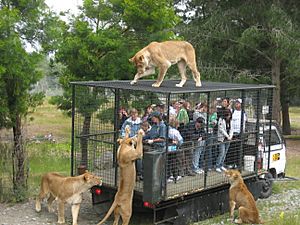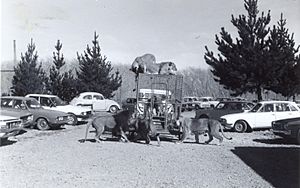Orana Wildlife Park facts for kids

Orana Wildlife Park Logo
|
|
| Date opened | 1976 |
|---|---|
| Location | Christchurch, New Zealand |
| Land area | 50 ha |
| Coordinates | 43°28′03″S 172°27′45″E / 43.4675°S 172.4625°E |
| No. of animals | 400+ |
| No. of species | 70+ |
| Memberships | ZAA |
Orana Wildlife Park is New Zealand's only open-range zoo. It's located on the edge of Christchurch and covers a huge area. The park first opened its doors in 1976. A special charity, the Orana Wildlife Trust, owns and runs the park.
The Trust has important goals. They want to give people in Christchurch and visitors a fun place to go. They also work to protect endangered animals, both native and from other countries. A big part of their mission is to teach visitors, especially kids, about nature and how to help save wildlife. They also support research to learn more about endangered animals.
Orana Wildlife Park gets most of its money from tickets and sales. But they also need to raise extra funds for big projects. Many people and groups have donated money to help the park grow. Over the years, they've built many animal homes and buildings themselves. Local businesses have also helped by giving materials and advice.
The park is home to more than 400 animals. These animals belong to over 70 different species. In 2015, Orana became the only place in New Zealand to have gorillas. Three male gorillas, including a big silverback, came to live at the park.
Orana Wildlife Park: A Journey Through Time
The Early Years: 1970–1975
In 1970, a group called the South Island Zoological Society was created. This group helped start the park. Orana's first animals arrived from Australia in September 1976. These included 18 lions, two tiger cubs, two camels, and two water buffalo. Orana Park officially opened its doors on September 25, 1976.
Growing the Park: 1976–1985
When it first opened, Orana had 28 animals from six species. Over the next ten years, many new animals joined the park. They also finished a big new area called Stage One of the African Plains.
The main attraction when Orana opened was the drive-through Lion Reserve. It was the only one like it in New Zealand. Visitors could drive their cars right through the lion habitat! This special experience ran from 1976 until 1995. Today, Orana offers a "special Lion Encounter" that reminds people of those early drive-through days.
In 1977, timber wolves arrived at the park. The Farmyard area was also created, which is still popular today. In 1978, an island home was built for spider monkeys. These were the park's first primates.
Two pairs of rare Scimitar-horned oryx came to Orana in 1979. These animals are very important to the park's story. Oryx were once extinct in the wild. But thanks to breeding programs in zoos, they are now back in protected areas. Orana was the first zoo in the world to breed oryx using a special method. Over 80 oryx have been born at the park!
In 1981, Stage One of the African Plains opened. This allowed visitors to see African animals like zebra and oryx. They were separated from visitors by water.
Giraffes joined the park in 1982. Orana has helped with a special program for giraffes in zoos. Over 15 giraffes have been born at Orana. Most of them have moved to other zoos.
New Zealand's first kiwi house was built in 1984. Orana now plays a big role in helping kiwi. Over 20 kiwi from Orana have been released into the wild. Kiwi chicks have also moved to other zoos.
New Animals and Changes: 1986–1995
Orana kept growing in its second decade. Many new species arrived, and the park continued to develop. A big change happened in 1995 when the drive-through Lion Reserve closed.
White rhinoceros came to Orana in 1986. In 1987, tuatara arrived. This started a focus on native reptiles. A new Reptile House was built the next year. Orana now has a great collection of native geckos.
The park expanded again in 1988 with Stage Two of the African Plains. This included a new Giraffe House. In 1990, a restaurant was added. It is now used as a Function Centre for events.
Cheetahs, the fastest land animals, arrived in 1988. Since then, Orana has been part of a breeding program for these fast cats. Cheetahs are hard to breed in zoos. But Orana has raised over 24 cheetahs to adulthood. In 1991, a 'Cheetah Chase' show started. This let visitors see how fast cheetahs can run.
Meerkats became one of the most popular additions in 1991. Many people came to see them when their new home, Kopje Rock, opened. This area now also has porcupines. Orana has successfully bred many meerkats.
A walk-through aviary for native birds opened in 1994. It has a waterfall and was built by the South Island Zoological Society. This aviary is home to birds like tui, kereru, and kakariki. Recently, tuatara and freshwater crayfish have also moved into the aviary.
A big change happened in 1995. The park's entrance moved to the middle of the park. Visitors could no longer drive their cars inside. Instead, they walked or used a safari shuttle. The shuttle was first introduced in 1986. Animal feeding times are scheduled throughout the day. This helps visitors see more and break up their walk.
Closing the park to cars meant the drive-through Lion Reserve ended. The lions moved to a new home. Later, they moved back to their current location.
New Experiences and Challenges: 1996–2005
This period brought important changes. New animal experiences were added. A formal education program started. The park also took over another attraction.
In 1996, New Zealand whio (blue duck) were added. Whio are very important for conservation at the park. Orana has bred these endangered native birds many times. They are then released into the wild.
African wild dogs arrived in 1998. These are some of the most endangered meat-eating animals in Africa.
In 1999, two new animal encounters were added for visitors.
Ibutho, New Zealand's first rhino calf, was born at Orana in 1999. This was a big achievement. It's hard for rhinos born in zoos to have babies. Orana has now bred three rhino calves.
In 2000, Orana started running the Southern Encounter Aquarium in Christchurch city. A kiwi house was added there in 2002. Sadly, this aquarium was destroyed in the 2011 Christchurch earthquake.
Asian small-clawed otters arrived in 2000. They got a new home near the meerkats. Brown teal, an endangered native duck, were added in 2004. They are now a key focus for conservation. Ducklings raised at Orana are often released into the wild. The singing Siamang gibbons, Orana's first apes, arrived in 2004. Three young gibbons have been born there.
Tigers Return and New Habitats: 2006–2013
This time saw the return of tigers and new animal homes. But the park also faced big challenges from earthquakes and storms.
A large habitat for the critically endangered Sumatran tiger was finished in 2006. Orana joined a group called 21st Century Tiger. Orana had tigers before, but they had passed away in 1999.
In October 2008, Orana took over running Nelson's Natureland Zoo. Natureland was going to close. In December 2008, a new meerkat exhibit was built. A porcupine habitat opened in December 2010. Orana later sold Natureland in 2013.
A walk-through kea habitat opened in 2009. It looks like a regenerating forest. Visitors walk on a boardwalk. They exit through a hut that teaches them about kea. Four kea chicks have been born in this aviary.
From 2010 to 2013, the zoo had to close for over 40 days. This happened nine separate times. Orana was lucky that the big Christchurch earthquakes of 2010 and 2011 caused little damage to the park itself. The main problem was that fewer visitors came. Usually, almost half of the park's visitors are from outside Christchurch.
Orana also faced other damaging events. These included floods, snowstorms that damaged exhibits, and strong winds. In September 2013, a very strong wind storm hit Christchurch. It left the zoo without power, water, or phones for eight days. The park had to close to the public for ten days. Despite these problems, visitor numbers slowly started to return to normal. Staff also began creating exciting new additions.
Gorillas Arrive: 2014–Present
The biggest new project was building a Great Ape Centre. This became home to New Zealand's only gorillas.
Gypsy horses arrived in 2014. Orana works with a special stud farm to manage these horses. Their arrival started a shift to having rare and interesting farm animals in the Farmyard.
Orana opened New Zealand's biggest Tasmanian devil habitat in December 2014. The park joined the Save the Tasmanian Devil Programme. This program helps raise awareness about these meat-eating marsupials. They are endangered because of a contagious cancer.
Great Ape Centre
On July 31, 2015, Orana opened a huge new home for New Zealand's only gorillas. This special habitat cost a lot of money to build.
Future Plans
A Maud Island Frog Habitat is being built. This will be for one of New Zealand's endangered frog species.
The next big project is a New Zealand Native Centre. This will help Orana do even more to protect native species.
Conservation Efforts
Orana is part of important zoo groups like the World Association of Zoos and Aquariums (WAZA). They also belong to the Zoo Aquarium Association of Australasia (ZAA). Being part of these groups means Orana helps with breeding programs for the endangered animals they have.
Helping Native Animals
Orana helps breed native animals for release into the wild. These include kiwi, blue duck (whio), and brown teal (pateke). So far, over 80 pateke, 50 whio, and 23 kiwi from Orana have been released. The park also helps attract native birds like bellbirds. They do this by restoring natural habitats on the park grounds.
Success with Exotic Species
Orana takes part in 23 zoo-based breeding programs for endangered species from other countries. They have had great success over the years. This includes breeding cheetahs, scimitar-horned oryx, white rhinoceros, and giraffes.



